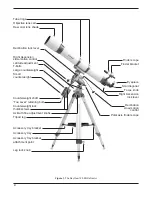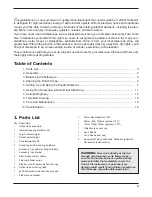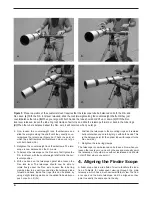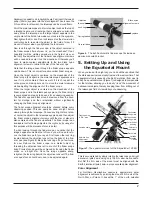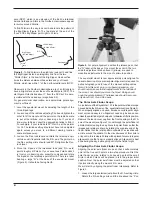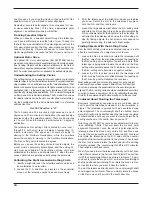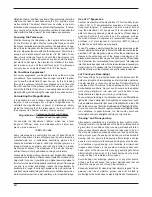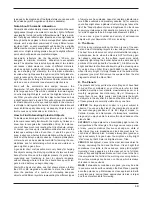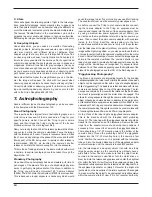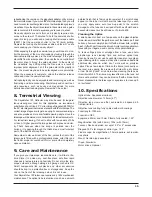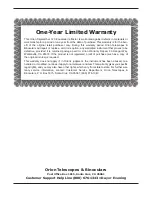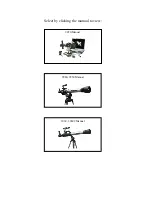
4
2. Assembly
Carefully open all of the boxes in the shipping container. Make
sure all the parts listed in Section 1 are present. Save the boxes
and packaging material. In the unlikely event that you need to
return the telescope, you must use the original packaging.
Assembling the telescope for the first time should take about
30 minutes. No tools are needed, other than the ones provid-
ed. All bolts should be tightened securely to eliminate flexing
and wobbling, but be careful not to over-tighten or the threads
may strip. Refer to Figure 1 during the assembly process.
During assembly (and anytime, for that matter), DO NOT
touch the surfaces of the telescope objective lens or the lens-
es of the finder scope or eyepieces with your fingers. The
optical surfaces have delicate coatings on them that can eas-
ily be damaged if touched inappropriately. NEVER remove
any lens assembly from its housing for any reason, or the
product warranty and return policy will be voided.
1. Lay the equatorial mount on its side. Attach the tripod legs
one at a time to the mount using the bolts installed in the
tops of the tripod legs. Remove the bolt from the leg, line
up the holes in the top of the leg with the holes in the base
of the mount, and reinstall the bolt so it passes through
the leg and the mount. Tighten the wingnuts only finger-
tight, for now. Note that the accessory tray bracket
attachment point on each leg should face inward.
2. Tighten the leg lock knobs at the base of the tripod legs.
For now, keep the legs at their shortest (fully retracted)
length; you can extend them to a more desirable length
later, after the scope is completely assembled.
3. With the tripod legs now attached to the equatorial mount,
stand the tripod upright (be careful!) and spread the legs
apart enough to connect each end of the accessory tray
bracket to the attachment point on each leg. Use the bolt
that comes installed in each attachment point to do this.
First remove the bolt using the supplied screwdriver, then
line up one of the ends of the bracket with the attachment
point and reinstall the bolt. Make sure the smooth side of
the accessory tray bracket faces up.
4. Now, with the accessory tray bracket attached, spread the
tripod legs apart as far as they will go, until the bracket is
taut. Attach the accessory tray to the brackets with the
three wingnut-head bolts already installed in the tray. Push
the bolts up through the holes in the bracket, then thread
them into the holes in the tray.
5. Next, tighten the wingnuts at the top of the tripod legs, so
the legs are securely fastened to the equatorial mount.
Use the larger wrench and your fingers to do this.
6. Orient the equatorial mount as it appears in Figure 1, at a
latitude of about 40°, i.e., so the pointer next to the latitude
scale (located directly above the Orion logo on one side of
the mount) is pointing to the line at “40.” To do this, loosen
one of the latitude adjusting T-bolts and then tighten the
other latitude adjusting T-bolt until the pointer and the “40”
line up (Figure 2). The declination (Dec.) and right ascen-
sion (R.A.) axes many need re-positioning (rotation) as
well. Be sure to loosen the RA and Dec. lock levers before
doing this. Retighten them once the equatorial mount is
properly oriented.
7. Thread the counterweight shaft in to the equatorial mount
at the base of the declination axis until tight. Make sure
the casting at the top of the bar is threaded clockwise as
far as it will go before attaching the shaft.
8. Remove the knurled “toe saver” retaining bolt on the bot-
tom of the counterweight shaft and slide both
counterweights onto the shaft. Make sure the counter-
weight lock thumbscrews are adequately loosened so the
metal pin inside the counterweight is recessed enough to
allow the counterweight shaft to pass through the hole.
Position the counterweights about halfway up the shaft
and tighten the lock thumbscrews. Replace the toe saver
on the end of the bar. It prevents the counterweights from
falling on your foot if the lock thumbscrews happen to
come loose.
9. Attach the two tube rings to the equatorial head using the
bolts that come installed in the rings. Remove the bolts, then
push them, with the washers still attached, up through the
holes in the tube ring mounting plate (on the top of the equa-
torial mount) and rethread them into the bottom of the tube
rings. Tighten the bolts securely with the smaller wrench.
Open the tube rings by loosening the knurled ring clamps.
10. Lay the telescope optical tube in the tube rings at about the
midpoint of the tube’s length. Rotate the tube in the rings
so the focus knobs are on the underside of the telescope.
Close the rings over the tube and tighten the knurled ring
clamps finger-tight to secure the telescope in position.
11. Now attach the two slow-motion cables to the R.A. and
Dec. worm gear shafts of the equatorial mount by position-
ing the setscrew on the end of the cable over the indented
slot on the worm gear shaft. Then tighten the setscrew.
Figure 2. To adjust the latitude angle of the equatorial
mount, loosen one of the two latitude adjustment T-bolts,
then tighten the other.


